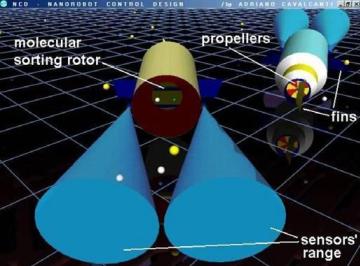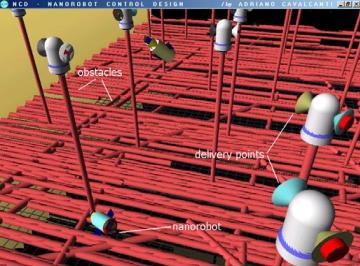The idea of using
nanorobots to deliver drugs and fight diseases such as
cancers is not new (check this
story for example). But there are still lots of
issues to solve before nanorobots can diagnose our
diseases and treat them. Now, an international team of
researchers has designed a software and hardware
platform of a
nanorobot to be used in medical applications. The
researchers think their nanorobots could become
available around 2015. But
read more...

You can see above the "nanorobots' design-sensors,
molecular sorting rotors, fins and propellers. The
depicted blue cones shows the sensors 'touching' areas."
In fact, these nanorobots can move with
six-degrees-of-freedom, i.e., arbitrary translation and
rotation fins and propellers. They also have specific
sensory capabilities to detect the target regions,
obstacles and chemicals relevant for their medical
application." (Credit: Adriano Cavalcanti and
colleagues)

This other image describes how nanorobots deliver
drugs -- at least in a virtual environment. "The 3D
environment contains nanorobots, obstacles, biomolecules
and specific medical targets. The medical targets
represent organ-inlets, displaced stochastically as
target locations or drug delivery points for medical
applications." (Credit: Adriano Cavalcanti and
colleagues)
The images above have been created by Adriano
Cavalcanti, the CEO and chairman of the Center for
Automation in Nanobiotech (CAN), who also is
researcher at Monash University in Melbourne. But he was
not alone. He was helped by Bijan
Shirinzadeh, an associate professor in the Robotics
and Mechatronics Research Laboratory at Monash
University in Melbourne, Robert Freitas, Jr.,
of the Institute for
Molecular Manufacturing in California, and Tad
Hogg who works for Hewlett-Packard Laboratories also
in California.
Now, let's look at the Cavalcanti's interview by nanotechweb.org.
Here is a question I would have asked. "Q: How can
nanorobots be achieved? A: In the same way
microelectronics has provided new medical devices in the
80s, now the miniaturization through nanotechnology is
enabling the manufacturing of nanobiosensors and
actuators to improve cell biology interfaces and
biomolecular manipulation. Fully operational nanorobots
for biomedical instrumentation should be achieved as a
result of nanobioelectronics and proteomics
integration."
And how simulation work help? "The methodologies and
the implemented 3D simulation described in our study
served as a test bed for molecular machine prototyping.
The numerical analysis and advanced simulations provided
a better understanding on how nanorobots should interact
inside the human body. Hence, based on such information,
we have proposed the innovative hardware architecture
with a nanorobot model for use in common medical
applications. The nanorobot takes chemical and thermal
gradient changes as interaction choices for in
vivo treatments. The use of mobile phones with RF is
adopted in this platform as the most effective approach
for control upload, helping to interface nanorobots
communication and energy supply."
In Virtual
3D nanorobots could lead to real cancer-fighting
technology, PhysOrg.com gives more details
about the 3D virtual nanorobots. "In a demonstration of
the real-time simulation, the nanorobots had the task of
searching for proteins in a dynamic virtual environment,
and identifying and bringing those proteins to a
specific “organ-inlet” for drug delivery. The
researchers analyzed how the nanorobots used different
strategies to achieve this goal. For instance, the
nanorobots could employ different sensory capabilities
such as chemical and temperature sensors, as well as
random movement. For the nanorobots, one of the most
difficult parts was maneuvering close enough to a
biomolecule to be able to sense that biomolecule, while
accounting for many different forces and moving bodies.
Unlike on the macroscale, viscosity dominates movement
in arteries, affecting the nanorobots’ traveling as it
encounters obstacles and proteins moving passively
through the fluid."
PhysOrg.com also asked Cavalcanti when these
nanorobots could become available to help us. "'If you
consider the velocity that miniaturization is moving,
from micro to nanoelectronics, then you can easily
understand the feasibility to have medical nanorobots
integrated as a nanoelectronic molecular machine before
2015,' he predicted, adding that nanorobots, like all
medical technologies, would still need to undergo safety
testing, which would push back the date for mass
production and commercialization."
This research work has been published in the January
9, 2008 issue of Nanotechnology under the name
"Nanorobot architecture for medical target
identification" (Volume 19, Number 1, Article 015103).
Here is an excerpt from the
abstract. "The nanorobots operate in a virtual
environment comparing random, thermal and chemical
control techniques. The nanorobot architecture model has
nanobioelectronics as the basis for manufacturing
integrated system devices with embedded nanobiosensors
and actuators, which facilitates its application for
medical target identification and drug delivery. The
nanorobot interaction with the described workspace shows
how time actuation is improved based on sensor
capabilities. Therefore, our work addresses the control
and the architecture design for developing practical
molecular machines. Advances in nanotechnology are
enabling manufacturing nanosensors and actuators through
nanobioelectronics and biologically inspired
devices."
From the link above, you can access to the
full paper (PDF format, 15 pages, 1.51 MB), from
which the above pictures have been picked. The access is
free to the Institute of
Physics registered users.
[Disclaimer: Adriano Cavalcanti thought I would be
interested by these progresses about nanorobots. Of
course, I was. Now it remains to be seen if some of my
readers also would be interested. Anyway, I have no
financial ties with Adriano Cavalcanti and his company.
For more information -- and pictures -- about his
research, please check his Nanorobotics
Control Design site.]
Finally, please drop me a note if you think these
future nanorobots can benefit to us or not.
Sources: nanotechweb.org, December 4, 2007; Lisa
Zyga, PhysOrg.com, December 5, 2007; and various
websites
You'll find related stories by following the links
below.
6:42:04 PM Permalink
|
